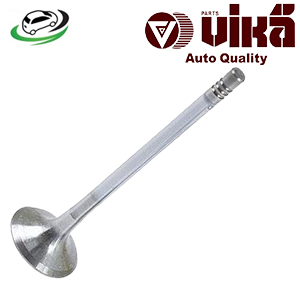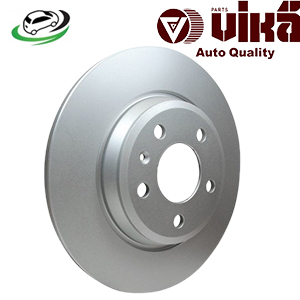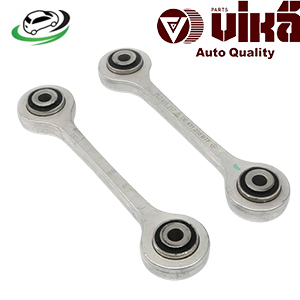-11%
Get Front Stabiliser Link AUDI Q7 2007-2015 7L0411317
The stabiliser link, also known as the sway bar link or anti-roll bar link, is a critical component of a vehicle’s suspension system. It plays a vital role in enhancing the stability and handling of the vehicle, especially during cornering and uneven road conditions. This guide will delve into the specifics of the stabiliser link, its functions, benefits, common issues, and maintenance practices.
What is a Stabiliser Link?
The stabiliser link is a mechanical linkage that connects the stabiliser bar (also known as the sway bar or anti-roll bar) to the suspension components of a vehicle. The stabiliser bar itself runs across the vehicle, connecting the left and right wheels through the suspension. The stabiliser link ensures that the stabiliser bar is properly connected and able to perform its function of reducing body roll during cornering.
How Does a Stabiliser Link Work?
The stabiliser link operates in conjunction with the stabiliser bar and the suspension system. Here’s how it works:
- Connecting the Stabiliser Bar: The stabiliser link connects the ends of the stabiliser bar to the suspension components, typically the control arms or struts. This connection allows the stabiliser bar to pivot and exert force on the suspension.
- Reducing Body Roll: When the vehicle corners, the suspension on one side of the vehicle compresses while the other side extends. The stabiliser bar twists due to this movement, and the stabiliser links transfer this force to the opposite side, reducing body roll and improving stability.
- Improving Handling: By reducing body roll, the stabiliser link helps maintain better contact between the tires and the road surface, enhancing the vehicle’s handling and traction, especially during sharp turns or sudden maneuvers.
- Absorbing Road Impact: The stabiliser links also help absorb some of the impact from uneven road surfaces, contributing to a smoother ride by distributing the forces more evenly across the suspension system.
Benefits of a Properly Functioning Stabiliser Link
A well-maintained stabiliser link offers several important benefits for vehicle performance and safety:
- Enhanced Stability: Properly functioning stabiliser links ensure that the stabiliser bar can effectively reduce body roll, providing better stability during cornering and high-speed maneuvers.
- Improved Handling: By maintaining better tire contact with the road, stabiliser links contribute to improved handling, making the vehicle more responsive and easier to control.
- Increased Safety: Reduced body roll and improved handling enhance overall vehicle safety, reducing the risk of losing control during sharp turns or sudden movements.
- Smoother Ride: Stabiliser links help absorb some of the impact from road irregularities, contributing to a smoother and more comfortable ride.
- Even Tire Wear: By maintaining proper alignment and reducing excessive movement in the suspension, stabiliser links can help promote even tire wear, extending the lifespan of the tires.
Common Issues with Stabiliser Links
Stabiliser links are subject to wear and tear due to their constant exposure to road conditions and the stresses of suspension movement. Common issues include:
- Worn Bushings: The bushings in the stabiliser links can wear out over time, leading to increased play and reduced effectiveness in controlling body roll. This can result in clunking noises and poor handling.
- Broken Links: The stabiliser links themselves can break due to fatigue or impact from road debris. A broken link will render the stabiliser bar ineffective, leading to increased body roll and decreased stability.
- Loose Connections: Over time, the connections between the stabiliser links and the suspension components can become loose, leading to excessive movement and noise. This can affect the vehicle’s handling and stability.
- Corrosion: Stabiliser links, especially those made of metal, can corrode due to exposure to moisture and road salt. Corrosion weakens the links and can lead to premature failure.
Signs of Failing Stabiliser Links
Identifying the signs of failing stabiliser links can help address issues before they lead to more severe problems. Common symptoms include:
- Clunking Noises: Unusual clunking or knocking noises, especially when driving over bumps or during cornering, can indicate worn or loose stabiliser links.
- Poor Handling: A noticeable decrease in handling performance, such as increased body roll during turns or a lack of responsiveness, can be a sign of failing stabiliser links.
- Uneven Tire Wear: If the tires exhibit uneven wear patterns, it may be due to improper suspension alignment caused by failing stabiliser links.
- Loose Steering: Loose or imprecise steering, especially during cornering, can indicate issues with the stabiliser links affecting the suspension geometry.
Maintenance and Replacement
Regular maintenance and timely replacement of stabiliser links are essential for ensuring reliable vehicle performance and safety. Here are some maintenance tips:
- Regular Inspections: Periodically inspect the stabiliser links and related components for signs of wear, damage, or corrosion. Regular maintenance can help identify issues early and prevent more severe problems.
- Tighten Connections: Ensure that all connections between the stabiliser links and the suspension components are properly tightened to prevent excessive movement and noise.
- Replace Worn Bushings: If the bushings in the stabiliser links show signs of wear or damage, replace them promptly to maintain proper suspension function.
- Use High-Quality Parts: When replacing stabiliser links, use high-quality parts that meet or exceed the manufacturer’s specifications to ensure durability and performance.
Replacement Procedure
Replacing stabiliser links typically involves the following steps:
- Preparation: Ensure the vehicle is on a level surface and secure it with jack stands if necessary. Gather the necessary tools and replacement stabiliser links.
- Remove the Old Links: Use the appropriate tools to remove the bolts or fasteners connecting the old stabiliser links to the stabiliser bar and suspension components. Carefully remove the old links from the vehicle.
- Install the New Links: Position the new stabiliser links in place and secure them with the appropriate bolts or fasteners. Ensure that the connections are properly tightened according to the manufacturer’s specifications.
- Check for Proper Alignment: After installing the new stabiliser links, check the alignment of the suspension components to ensure proper function and handling.
- Test Drive: Take the vehicle for a test drive to ensure that the new stabiliser links and suspension system are functioning correctly and that there are no issues with noise or handling.
Follow us on Facebook for more parts.



